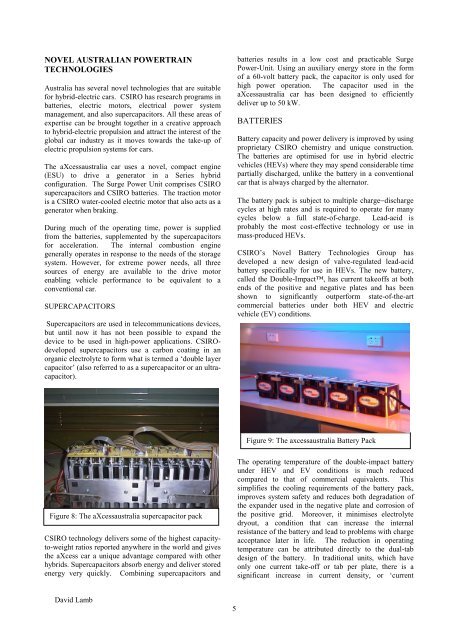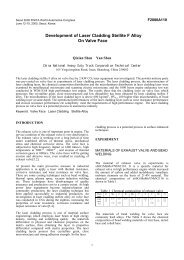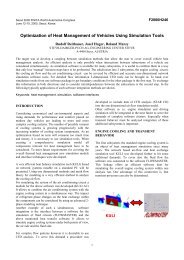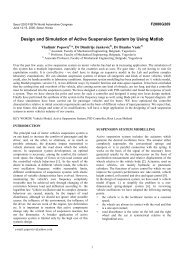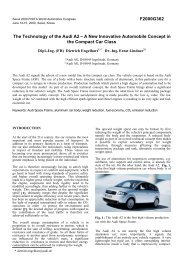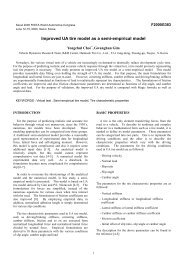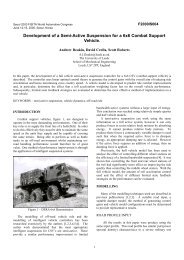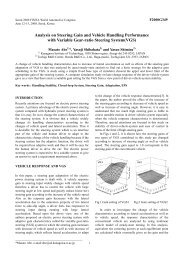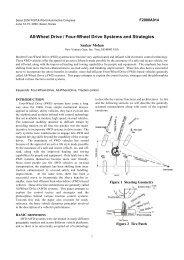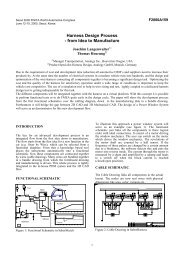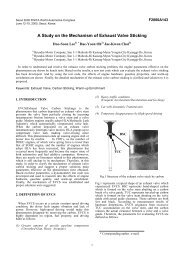The aXcessaustralia Hybrid Electric Car Project
The aXcessaustralia Hybrid Electric Car Project
The aXcessaustralia Hybrid Electric Car Project
You also want an ePaper? Increase the reach of your titles
YUMPU automatically turns print PDFs into web optimized ePapers that Google loves.
NOVEL AUSTRALIAN POWERTRAINTECHNOLOGIESAustralia has several novel technologies that are suitablefor hybrid-electric cars. CSIRO has research programs inbatteries, electric motors, electrical power systemmanagement, and also supercapacitors. All these areas ofexpertise can be brought together in a creative approachto hybrid-electric propulsion and attract the interest of theglobal car industry as it moves towards the take-up ofelectric propulsion systems for cars.<strong>The</strong> <strong>aXcessaustralia</strong> car uses a novel, compact engine(ESU) to drive a generator in a Series hybridconfiguration. <strong>The</strong> Surge Power Unit comprises CSIROsupercapacitors and CSIRO batteries. <strong>The</strong> traction motoris a CSIRO water-cooled electric motor that also acts as agenerator when braking.During much of the operating time, power is suppliedfrom the batteries, supplemented by the supercapacitorsfor acceleration. <strong>The</strong> internal combustion enginegenerally operates in response to the needs of the storagesystem. However, for extreme power needs, all threesources of energy are available to the drive motorenabling vehicle performance to be equivalent to aconventional car.SUPERCAPACITORSSupercapacitors are used in telecommunications devices,but until now it has not been possible to expand thedevice to be used in high-power applications. CSIROdevelopedsupercapacitors use a carbon coating in anorganic electrolyte to form what is termed a ‘double layercapacitor’ (also referred to as a supercapacitor or an ultracapacitor).batteries results in a low cost and practicable SurgePower-Unit. Using an auxiliary energy store in the formof a 60-volt battery pack, the capacitor is only used forhigh power operation. <strong>The</strong> capacitor used in the<strong>aXcessaustralia</strong> car has been designed to efficientlydeliver up to 50 kW.BATTERIESBattery capacity and power delivery is improved by usingproprietary CSIRO chemistry and unique construction.<strong>The</strong> batteries are optimised for use in hybrid electricvehicles (HEVs) where they may spend considerable timepartially discharged, unlike the battery in a conventionalcar that is always charged by the alternator.<strong>The</strong> battery pack is subject to multiple charge−dischargecycles at high rates and is required to operate for manycycles below a full state-of-charge. Lead-acid isprobably the most cost-effective technology or use inmass-produced HEVs.CSIRO’s Novel Battery Technologies Group hasdeveloped a new design of valve-regulated lead-acidbattery specifically for use in HEVs. <strong>The</strong> new battery,called the Double-Impact, has current takeoffs at bothends of the positive and negative plates and has beenshown to significantly outperform state-of-the-artcommercial batteries under both HEV and electricvehicle (EV) conditions.Figure 9: <strong>The</strong> axcessaustralia Battery PackFigure 8: <strong>The</strong> <strong>aXcessaustralia</strong> supercapacitor packCSIRO technology delivers some of the highest capacityto-weightratios reported anywhere in the world and givesthe aXcess car a unique advantage compared with otherhybrids. Supercapacitors absorb energy and deliver storedenergy very quickly. Combining supercapacitors and<strong>The</strong> operating temperature of the double-impact batteryunder HEV and EV conditions is much reducedcompared to that of commercial equivalents. Thissimplifies the cooling requirements of the battery pack,improves system safety and reduces both degradation ofthe expander used in the negative plate and corrosion ofthe positive grid. Moreover, it minimises electrolytedryout, a condition that can increase the internalresistance of the battery and lead to problems with chargeacceptance later in life. <strong>The</strong> reduction in operatingtemperature can be attributed directly to the dual-tabdesign of the battery. In traditional units, which haveonly one current take-off or tab per plate, there is asignificant increase in current density, or ‘currentDavid Lamb5


